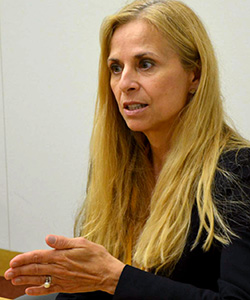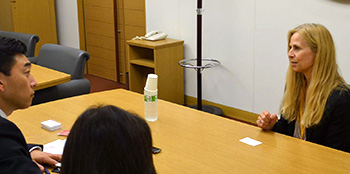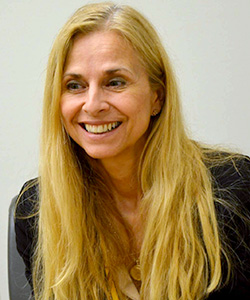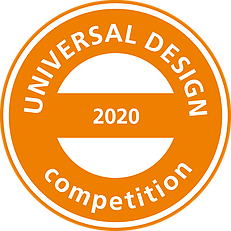It is my dream that to combine Scandinavian design and Japanese technology and to create excellent products.
2013.04.14 Updated

Onny Eikhaug
Programme Leader, Design for all, Norwegian Design Council: Norway
Interviewer: Hideki Akiya (Toyota Boshoku Corporation)
Interview date: Oct. 12, 2012 PM 19:00-
— First of all, it has been 10 years since IAUD was established in 2002. What do you think of the progress of Japanese universal design in the last 10 years?
Onny Eikhaug: I started in this field of universal design in 2005 and that’s when I discovered IAUD. Maybe I haven’t knowledge of the total of 10 years period but I can definitely talk from when I started within universal design. In 2005, I started to look at what was achieved in Japan already from the beginning because I was always looking for the good business examples that proved the thinking and that could convince industry in Norway that this is a good strategy and also a strategy for innovation to be more people-centered and inclusive, and to prove that this is also good business. I was amazed the first time I came to Japan and looked at all the fantastic solutions that was already on the market because this is what we lack in Europe, the practical solutions on the market. I would always use a lot of good examples, Toyota, Panasonic, and so on. These are the most famous brands. You also have amazing brands like Toto and Sekisui. I used these examples in my talks and presentations. I have written a book about universal design and I always looked at Japan.
The only thing if I could say something is that I wish that Japanese companies started exporting their universal design solutions into Europe. Maybe their needs to be some Europeanification or adjustment to Europe markets but I think you have a huge possibility for your technological solutions in Europe because we do have an aging population. We have the need for these types of solutions in every area of the market. I think it’s really a big potential for you there.
— I thought especially the Scandinavian design is edge of the universal design so I’m very surprised you expect us to export our products.
Onny Eikhaug: It’s true. I think it’s just that we don’t have the big technological producers and industry like you have. What you have can complement what we have in our approach because I think we are small countries and our industry is small. We don’t have money and possibilities for research and development. It’s not easy for us to develop and arrive at the same innovative solutions that you have already done because you are ahead of us. The difference between Scandinavian markets and Japan is that you have a market drive for universal design. There is already a demand for it. This is a major factor. This is what impressed me with IAUD that you have 130 something industrial companies with the universal design strategy already developing universally designed product for a market and you have the customers already there. It’s a bit different in Scandinavia. we are still looking for these technical solutions. However, national legislation and governmental initiative are considered to be very important, and the public institutions are driving such movement. I think, in terms of universal design, public transportation and government-initiative projects have more made progress. But private companies are still behind in universally designed buildings, public spaces, and something new.
In Norway, we have a very good social security system, it’s a Nordic model. Scandinavian countries actually all have that and so it’s like the state taking care of older people. You will get the nursing homes and so on, but this was the case but it will change because there is a gap now between employed people and retired people.
The government wants people to manage on their own at home and live independently longer. It’s very costly to send people to a nursing home, which bears down on the government. We need new systems and services to make sure aging people, even if they have any disability, can live their life independently longer, that’s why we have a need for your technologies and solutions.
— The second question, how do you feel about what is our Japanese role to progress universal design in Asian area?
 Onny Eikhaug: I’m not an expert in the Asian area. I’ve been to Hong Kong recently, I’ve been to Japan four times. This is my fourth time, but I see that you are facing challenges with an aging population but also with the sustainability issue. I think that with your history of innovation and technological progress you are being able I think to be at the forefront of this development still for the years to come if you have also continue to have a people-centered approach. But, I also think it is still in a state of development. Countries have respective provincialism, therefore I think even if you have a technical solution, there might be needs for cultural aesthetical adjustments for solutions to work in a specific country. I just want to add something. I think that the way for the future to develop is by working more together, more open source, more network. I think there’s a lot of proof that this is actually profitable for all parts when you start cooperating across company borders and countries. I think collaboration is the key.
Onny Eikhaug: I’m not an expert in the Asian area. I’ve been to Hong Kong recently, I’ve been to Japan four times. This is my fourth time, but I see that you are facing challenges with an aging population but also with the sustainability issue. I think that with your history of innovation and technological progress you are being able I think to be at the forefront of this development still for the years to come if you have also continue to have a people-centered approach. But, I also think it is still in a state of development. Countries have respective provincialism, therefore I think even if you have a technical solution, there might be needs for cultural aesthetical adjustments for solutions to work in a specific country. I just want to add something. I think that the way for the future to develop is by working more together, more open source, more network. I think there’s a lot of proof that this is actually profitable for all parts when you start cooperating across company borders and countries. I think collaboration is the key.
— I think we Japanese and many people who live in Asia have changed our sense of security since Japanese met the tragic earthquake and tsunami last year. Now we have two points: first is saving our life from the future natural disaster; second, getting back our safety daily life after disaster. These two issues are very serious problems for us. Then, I have a third question. What do you think of how do we have to do to realize sustainable society in terms of saving life and recovering our daily safety life after disaster?
Onny Eikhaug: Yeah, well first I must say in our country, we have been very impressed with the Japanese people how you have handled the catastrophe and the disaster, and how you have been strong and very disciplined in your approach. Also the Japanese government has handled this problem methodologically.
But, what I think you learned a lot of lessons. The way of responding to sustainability, safety, and security is a matter of significance. In this disaster, you learned lessons in the extremely hard way. Through such experiences, we have seen that certain solutions and systems are not always safe and secured in a disaster. There is a lack of a – like the speaker said imagination of worst scenario. Therefore I think that we have to look at the diversity of everything including people, and environmental and sustainability issues when we build future solutions.
I think there will always be disasters but it’s also how the systems are geared to tackle it. But, when it comes to the big question of rebuilding I think it’s also governmental, political question of how a nation will offer support and dedicate solutions and funding for building ruined societies and local communities.
I just want to add one thing quick, when you are building up new structures, the demographic change of the area should be taken care of. That is, we have to construct buildings to suit the local characteristics. This is also what I see when we discussed the solutions for disasters and those for emergencies at the UN Head Office in Geneva do not always work fine because emergency solutions are not always people-centered.
— Thank you. Just a very, very personal question. You studied universal design from you said 2005 almost 7 years. Before doing that, what was your specialty? Your point of view is very interesting.
Onny Eikhaug: Yes I’m a business person. I’ve been working until 2005 in private industry, starting with Unilever. I was always involved with the product development and marketing and so on but always used to work with design. I realized that design is a very important tool, a strategic tool for businesses but also for innovation. This is why I’ve been working with different fields like lighting, furniture, graphic design, and so on. I was also at the board of the Norwegian Design Council, when I was in the industry, I had been collaborating with the Norwegian Design Council for a long time and then this special project program was established and I was given the job because of my background with industry and design.
— Fantastic. Finally I would like to know your expectation or request to the activities of universal design in Japan.
 Onny Eikhaug: In general, I always come here for inspiration and to see how you are dealing with practical solutions and to continue to network with the universal design experts and companies in Japan to knowledge transfer, to exchange knowledge and to update myself in what’s going on in Japan market within the field of universal design, because in many ways Japan is leading the way. I think it is useful for our countries to exchange the experiences. Therefore, it’s important for me to come here to establish networks and to learn about your progress. I always also use examples from Japanese industry and I invite speakers from Japan when I run conferences. We have had people from Toyota, Panasonic and IAUD executive committee, Kawahara-san (executive director of IAUD). The designer of the Nanakumasen has also been to Norway. It’s very important for us and I want to continue this.
Onny Eikhaug: In general, I always come here for inspiration and to see how you are dealing with practical solutions and to continue to network with the universal design experts and companies in Japan to knowledge transfer, to exchange knowledge and to update myself in what’s going on in Japan market within the field of universal design, because in many ways Japan is leading the way. I think it is useful for our countries to exchange the experiences. Therefore, it’s important for me to come here to establish networks and to learn about your progress. I always also use examples from Japanese industry and I invite speakers from Japan when I run conferences. We have had people from Toyota, Panasonic and IAUD executive committee, Kawahara-san (executive director of IAUD). The designer of the Nanakumasen has also been to Norway. It’s very important for us and I want to continue this.
And also, I have a dream of combining Scandinavian design skills, we have many good very clever Norwegian designers, with the Japanese technology.
— Thank you very much.
Inquiries
![]() Please make your inquiry here (you will be automatically transferred to the Inquiries page).
Please make your inquiry here (you will be automatically transferred to the Inquiries page).






![[Global Interview 2016] It would be very appreciated if Japan or IAUD could provide and share information and strategies to Europe. 画像](https://www.iaud.net/file/en/sites/3/03bade-1-320x289.jpg)
![[Global Interview 2016] It will be wonderful if the first-ever united Games of the Olympics for non-handicapped people and the Paralympics for handicapped people is realized in Japan in 2020. 画像](https://www.iaud.net/file/en/sites/3/04balaram-1-320x172.jpg)
![[Global Interview 2016] It will be great if the year 2020 becomes a good opportunity for the whole society to raise awareness of design, thereby changing the society for the better. 画像](https://www.iaud.net/file/en/sites/3/01wessler-1-320x279.jpg)
